The text, Foundations of Semantic Web Technologies by Pascal Hitzler, Markus Krtzsch, and Sebastian Rudolph says on page 162.
And this answer says,
You can write p has range D as
⊤ ⊑ ∀p.D
which says that ⊤ (or
owl:Thing, i.e., everything) is such that every one of its values for p must be a D. By using inverse properties, you can get domain axioms as well. p has domain C is equivalent to⊤ ⊑ ∀p-1.C
As we can see, the two expressions for range from the book and the answer match. I can not find how the expressions for domain are equivalent.
In the expression from the mentioned answer,
⊤ ⊑ ∀p-1.C
if we apply ∀p to both the sides, we get,
∀p.⊤ ⊑ C
The above differs from the one given in the book.
What is it I could be missing here?
